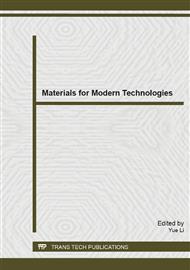p.249
p.254
p.259
p.263
p.268
p.275
p.285
p.289
p.293
Precipitation Behavior of the Second Phase Particles in Grain Oriented Silicon Steel Slabs under Different Reheating Conditions
Abstract:
The grain oriented silicon steel slabs were reheated at 1323K~1623K with different soaking time in this study. The precipitation behavior of the second phase particles in the steel slabs was investigated by using SEM/EDS combined with other analytic tools. The results show that the main precipitations in samples are MnS and AlN bearing a little of CuxS, and they frequently aggregate with each other by two or three types of precipitations. The quantities of the above three types of precipitations are up to 90% in each sample. These complex precipitations change into AlN bearing a little of CuxS or single AlN after being reheated. The shapes of MnS or AlN havent the common spherical or quadrilateral characteristic outline. There are a few of spherical or irregular shape inclusions such as SiO2, Al2O3, TiO2, CaO, CaS and their complex in the samples. Part of MnS or AlN can also grow around with these particles and then dissolves after being reheated. The sizes of the particles are main in the range of 0.05~0.2μm. There are no inclusions larger than 5.0μm in size observed in the fields of view. The volume density of the precipitations 0.05~0.2μm in size extracted from the quenched samples at 1523K using non aqueous solution electroextraction are 4.04×104 /mm3, 4.73×104 /mm3, 3.70×104 /mm3, 3.33×104 /mm3, 3.10×104 /mm3 and 1.56×104 /mm3 as the corresponding reheating time is 10min, 30min, 60min, 90min, 120min and 240min at 1523K respectively. The average size of them is 0.108μm. It is more precise to statistics the volume density of the particles in the steel by electrolysis extracting method than that of using metallogrphical analysis. No obvious microstructure variation was observed in the quenched samples after annealing different time. When the reheating temperature reaches 1523K and 1623 K, the grain size grows more easily and the grain boundary gets smoothly. The grain boundary of the samples becomes clear with the increase of the annealing temperature during the same annealing time. The reheating temperature in the present slab is chosen at 1523K and the reheating time is kept for 120 min, which will insure the particles in the slab to dissolve more completely and avoid grain growth abnormally at high temperature.
Info:
Periodical:
Pages:
268-274
Citation:
Online since:
April 2014
Authors:
Price:
Сopyright:
© 2014 Trans Tech Publications Ltd. All Rights Reserved
Share:
Citation:


